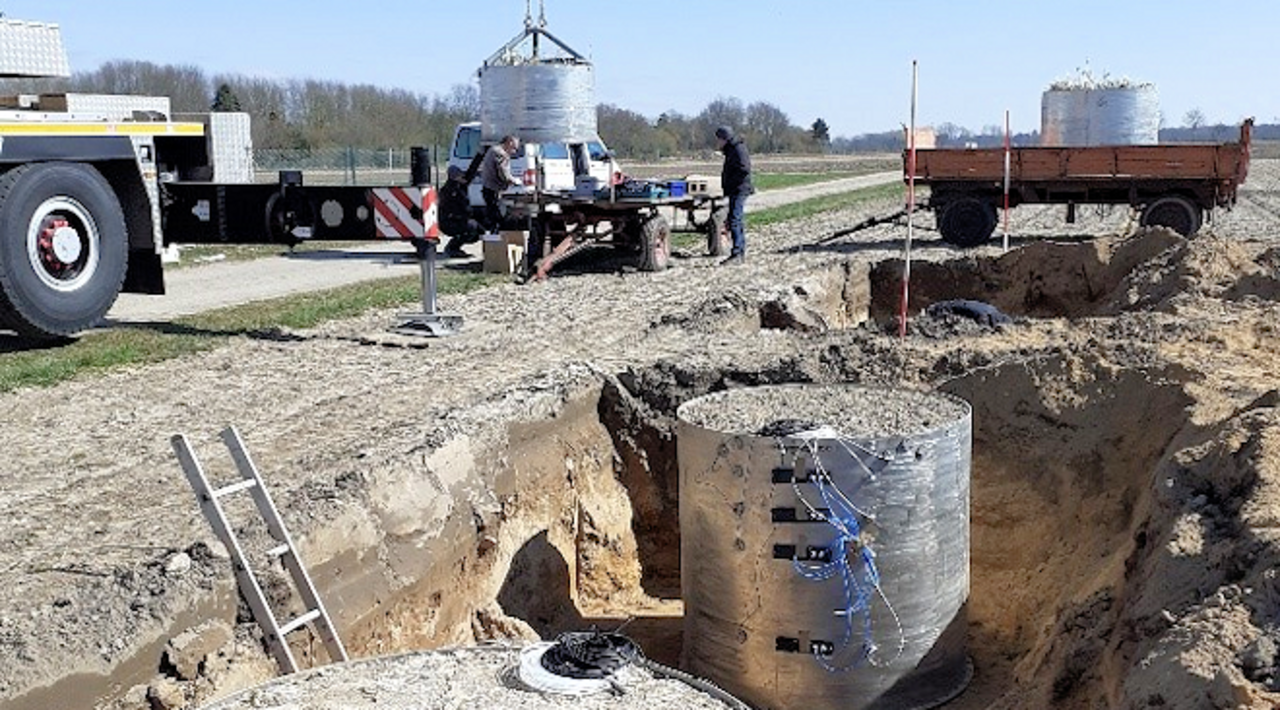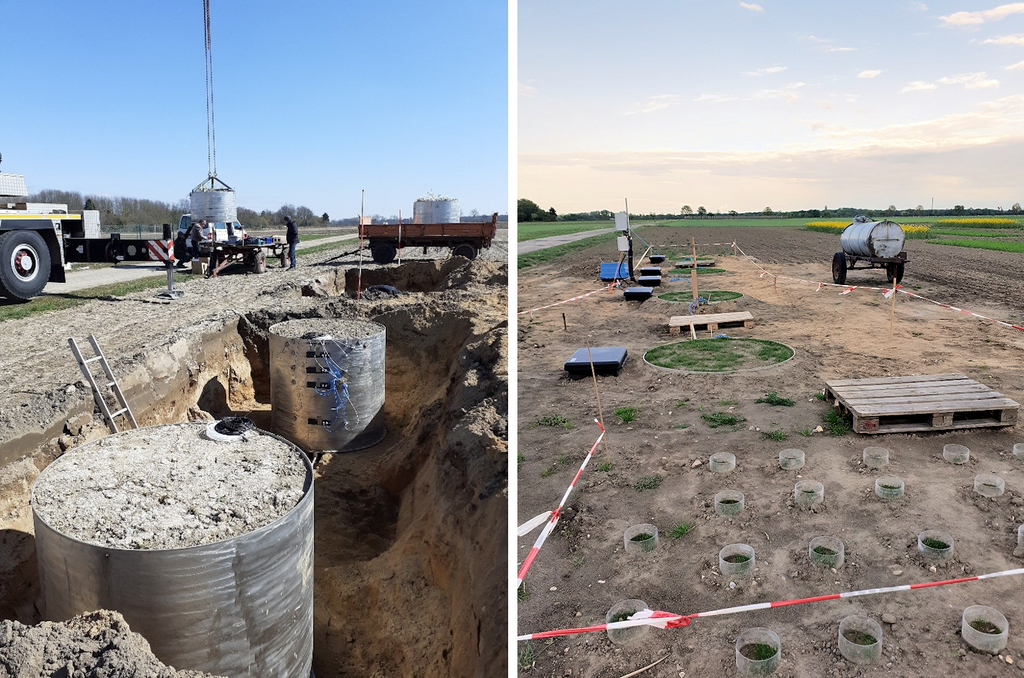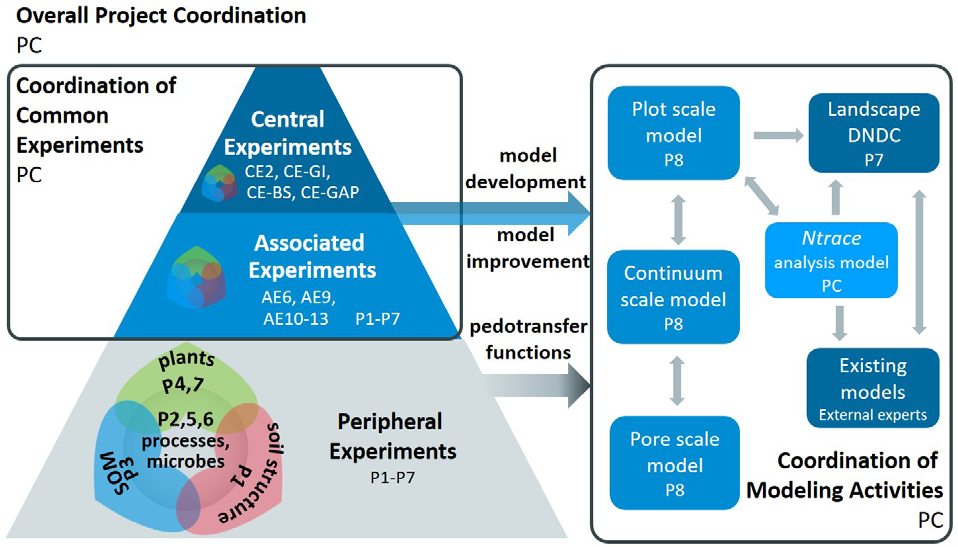Project
Denitrification control in agricultural soils II

Measuring N2 and N2O fluxes and related processes at high sensitivity and resolution in the field using advanced isotopic tools as a basis for model evaluation – Subproject P6 of the research unit "Denitrification in Agricultural Soils: Integrated Control and Modelling at Various Scales” (DFG RU 2337)
To better predict gaseous nitrogen emissions from agricultural soils via microbial processes, robust data on N2 emissions and oxygen depletion in soil are needed. Our task is to conduct field and laboratory studies in order to address this knowledge gap.
Background and Objective
Denitrification is the anaerobic microbial process through which nitrate (NO3-) and nitrite (NO2-) are reduced to molecular nitrogen (N2) via the following reaction steps: NO3- → NO2- → NO → N2O → N2. A significant fraction of the nitrous oxide (N2O) produced within this process is not further reduced to N2 and instead constitutes the main emission source of this greenhouse gas from agricultural soils. Hence, our understanding and ability to quantify soil denitrification is crucial for reducing N2O emissions and nitrogen fertiliser loss.
Robust denitrification data suitable to validate N2 fluxes in denitrification models are scarce due to the methodological complexities in collecting such data and the extreme spatio-temporal heterogeneity of denitrification. The coordinated DFG research unit „Denitrification in Agricultural Soils: Integrated Control and Modelling at Various Scales (DASIM)” (http://www.dasim.de) investigates the denitrification process chain in agricultural soils using advanced analytical and molecular biological methods as well as field studies and various modelling approaches. The aim is to investigate the activity and regulation of denitrification in unprecedented spatial and temporal resolution and to use the results to develop mathematical models from the micro-scale to the field scale, in order to improve existing simulation approaches.
Target Group
Scientific community
Approach
DASIM is a joint project, which is divided into eight different parts. At the Thuenen Institute of Climate-Smart Agriculture, we will address the questions in Subproject P6. Our tasks are to:
- determine the minimum soil averaging volume for N2 and N2O fluxes from arable soils.
- determine the anaerobic soil volume fraction of the DASIM soils under varying conditions. Although an essential control variable for denitrification, few studies have focused on quantifying anaerobic soil volume fraction, due to the difficulty in measuring its control factors. However, appropriate methods are now available.
- further develop and test the enhanced 15N gas flux method (15NGF+) in order to improve accuracy and better quantify the spatial distribution of denitrification activity.
- establish a field measurement system combining in situ analysis with 15NGF+.
- calibrate the isotopocule mapping approach using controlled lab incubations under an N2-free atmosphere.
- quantify N2 and N2O fluxes, contributing processes and control factors in cropped soils to determine field-scale denitrification dynamics and use these as a basis for model calibration and validation.
- evaluate and further develop selected biogeochemical models using the measured data.

Our Research Questions
The questions to be addressed across the entire DASIM research unit are:
- How is the activity of denitrifiers and their community structure controlled at the micro-scale?
- How is denitrification affected and controlled by other simultaneously occurring N cycling processes?
- What controls the development of “hot spots” (i.e. specialised habitats) and “hot moments” (i.e. temporary hot spots) for denitrification activity?
- Do fundamental relationships exist between controls of denitrification at various scales (from micro- to meso- to field-scale)?
- Is it possible to predict denitrification of a given soil in response to atmospheric boundary conditions based on measurable structural and biochemical properties?
The questions addressed in our subproject (P6) are:
- How are N2, N2O and NO fluxes and their interaction with different N-transformation processes affected by physical, chemical and microbiological control factors at the field scale?
- What is the size of the minimum averaging volume for N2 and N2O fluxes from arable soils?
- How can we quantify the anaerobic soil volume fraction and to which extent can this measurement be used to improve denitrification models?
Links and Downloads
Thünen-Contact

Involved Thünen-Partners
Involved external Thünen-Partners
- Julius Kühn-Institut - Bundesforschungsinstitut für Kulturpflanzen (JKI)
(Quedlinburg, Braunschweig, Groß Lüsewitz, Kleinmachnow, Deutschland) -
Umweltforschungszentrum
(Halle (Saale), Deutschland) -
Martin-Luther-Universität Halle-Wittenberg
(Halle (Saale), Deutschland) -
Leibniz Universität Hannover
(Hannover, Deutschland) - Georg-August-Universität Göttingen
(Göttingen, Deutschland) -
Justus-Liebig-Universität Gießen
(Gießen, Deutschland) -
Technical University of Clausthal
(Clausthal, Deutschland) -
Karlsruher Institut für Technologie (KIT)
(Garmisch-Partenkirchen, Deutschland) -
Friedrich-Schiller-Universität Jena
(Jena, Deutschland) -
Norwegian University of Life Sciences
(Ås, Norwegen) - Forstliche Versuchs- und Forschungsanstalt Baden-Württemberg
(Freiburg, Deutschland) - Georg-August-Universität Göttingen
(Göttingen, Deutschland)
Funding Body
-
Deutsche Forschungsgemeinschaft (DFG)
(national, öffentlich)
Duration
1.2020 - 12.2023
More Information
Project funding number: WE 1904/10-2
Project status:
finished
Publications
- 0
Grosz BP, Matson A, Butterbach-Bahl K, Clough TJ, Davidson E, Dechow R, Del Grosso S, Diamantopoulos E, Dörsch P, Haas E, He H, Henri CV, Hui D, Kleineidam K, Kraus D, Kuhnert M, Léonard J, Müller C, Petersen SO, Well R, et al (2023) Modeling denitrification: Can we report what we don't know? AGU Advances 4(6):e2023AV000990, DOI:10.1029/2023AV000990
- 1
Micucci G, Sgouridis F, McNamara NP, Krause S, Lynch I, Roos F, Well R, Ullah S (2023) The 15N-Gas flux method for quantifying denitrification in soil: Current progress and future directions. Soil Biol Biochem 184:109108, DOI:10.1016/j.soilbio.2023.109108
- 2
Rummel PS, Well R, Pausch J, Pfeiffer B, Dittert K (2021) Carbon availability and nitrogen mineralization control denitrification rates and product stoichiometry during initial maize litter decomposition. Appl Sci 11(11):5309, DOI:10.3390/app11115309
- 3
Rohe L, Apelt B, Vogel H-J, Well R, Wu G-M, Schlüter S (2021) Denitrification in soil as a function of oxygen availability at the microscale. Biogeosciences 18(3):1185-1201, DOI:10.5194/bg-18-1185-2021
- 4
Bracken C, Lanigan GJ, Richards KG, Müller C, Tracy SR, Well R, Carolan R, Murphy PNC (2021) Development and verification of a novel isotopic N2O measurement technique for discrete static chamber samples using cavity ring-down spectroscopy. Rapid Comm Mass Spectrometry 35(8):e9049, DOI:10.1002/rcm.9049
- 5
Grosz BP, Well R, Dechow R, Köster JR, Khalil MI, Merl S, Rode A, Ziehmer B, Matson A, He H (2021) Evaluation of denitrification and decomposition from three biogeochemical models using laboratory measurements of N2, N2O and CO2. Biogeosciences 18(20):5681-5697, DOI:10.5194/bg-18-5681-2021
- 6
Zaman M, Kleineidam K, Bakken LR, Berendt J, Bracken C, Butterbach-Bahl K, Cai Z, Chang SX, Clough TJ, Dawar K, Ding W, Dörsch P, dos Reis Martins M, Eckhardt C, Fiedler S, Frosch T, Goopy J, Görres C-M, Gupta A, Well R, et al (2021) Measuring emission of agricultural greenhouse gases and developing mitigation options using nuclear and related techniques : Applications of nuclear techniques for GHGs. Cham: Springer, 337 p, DOI:10.1007/978-3-030-55396-8
- 7
Rummel PS, Well R, Pfeiffer B, Dittert K, Floßmann S, Pausch J (2021) Nitrate uptake and carbon exudation - do plant roots stimulate or inhibit denitrification? Plant Soil 459:217-233, DOI:10.1007/s11104-020-04750-7
- 8
Lewicka-Szczebak D, Lewicki MP, Well R (2020) N2O isotope approaches for source partitioning of N2O production and estimation of N2O reduction - validation with the 15N gas-flux method in laboratory and field studies. Biogeosciences 17(22):5513-5537, DOI:10.5194/bg-17-5513-2020
- 9
Petersen S, Well R, Taghizadeh-Toosi A, Clough TJ (2020) Seasonally distinct sources of N2O in acid organic soil drained for agriculture as revealed by N2O isotopomer analysis. Biogeochemistry 147(1):15-33, DOI:10.1007/s10533-019-00625-x

![[Translate to English:] [Translate to English:]](/media/_processed_/6/4/csm_titel_CO2Kampagne8_afeea2273e.png)
![[Translate to English:] [Translate to English:]](/media/_processed_/4/1/csm_titel_93px_CO2Kampagne8_9b0f3354d4.png)

![[Translate to English:] Logo des Bundesministerium für Ernährung und Landwirtschaft](/media/allgemein/logos/BMEL_Logo.svg)